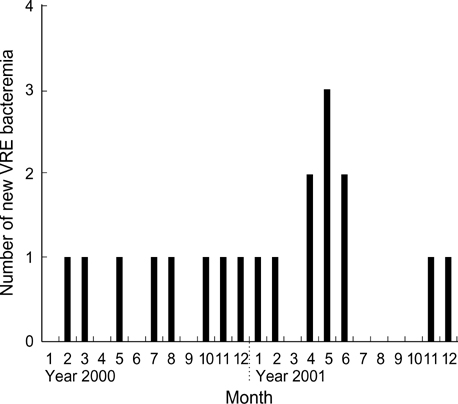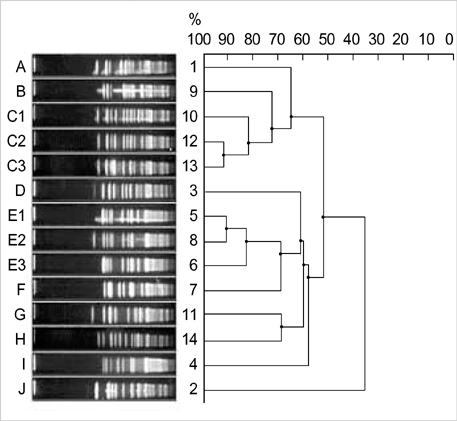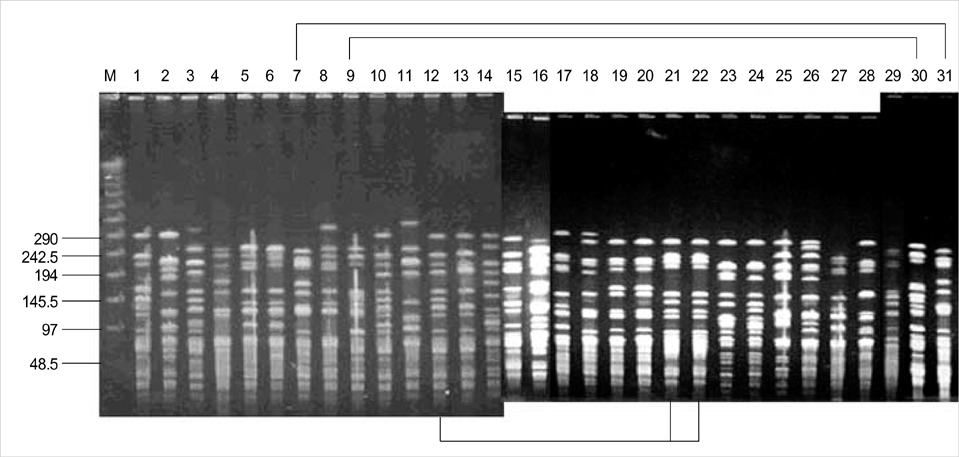J Korean Med Sci.
2005 Apr;20(2):169-176. 10.3346/jkms.2005.20.2.169.
Vancomycin-resistant Enterococcal Bacteremia in a Hematology Unit: Molecular Epidemiology and Analysis of Clinical Course
- Affiliations
-
- 1Department of Internal Medicine, The Catholic Haematopoietic Stem Cell Transplantion Center, The Catholic University of Korea, College of Medicine, Seoul, Korea. fire@catholic.ac.kr
- 2Department of Laboratory Medicine, Yonsei university College of Medicine, Seoul, Korea.
- KMID: 1095185
- DOI: http://doi.org/10.3346/jkms.2005.20.2.169
Abstract
- An increase in vancomycin-resistant enterococcal (VRE) bacteremia in hemato-oncological patients (n=19) in our institution from 2000 through 2001 led us to analyze the molecular epidemiologic patterns and clinical features unique to our cases. The pulsed field gel electrophoresis of the isolates revealed that the bacteremia was not originated from a single clone but rather showed endemic pattern of diverse clones with small clusters. A different DNA pattern of blood and stool isolates from one patient suggested exogenous rather than endogenous route of infection. Enterococcus faecium carrying vanA gene was the causative pathogen in all cases. Patients with VRE bacteremia showed similar clinical courses compared with those with vancomycin-susceptible enterococcal (VSE) bacteremia. Vancomycin resistance did not seem to be a poor prognostic factor because of similar mortality (5/8, 62.5%) noted in VSE bacteremia. Initial disease severity and neutropenic status may be major determinants of prognosis in patients with VRE bacteraemia.
Keyword
MeSH Terms
Figure
Cited by 1 articles
-
Multidrug-resistant Organisms and Healthcare-associated Infections
Mi-Na Kim
Hanyang Med Rev. 2011;31(3):141-152. doi: 10.7599/hmr.2011.31.3.141.
Reference
-
1. Cetinkaya Y, Falk P, Mayhall CG. Vancomycin-resistant enterococci. Clin Microbiol Rev. 2000. 13:686–707.
Article2. Vergis EN, Hayden MK, Chow JW, Snydman DR, Zervos MJ, Linden PK, Wagener MM, Schmitt B, Muder RR. Determinants of vancomycin resistance and mortality rates in enterococcal bacteremia: a prospective multicenter study. Ann Intern Med. 2001. 135:484–492.
Article3. Lee K, Jang SJ, Lee HJ, Ryoo N, Kim M, Hong SG, Chong Y. The Korean Nationwide Surveillance of Antimicrobial Resistance Group. Increasing prevalence of vancomycin-resistant Enterococcus faecium, expanded-spectrum cephalosporin-resistant Klebsiella pneumoniae, and imipenem-resistant Pseudomonas aeruginosa in Korea: KONSAR Study in 2001. J Korean Med Sci. 2004. 19:8–14.4. Lee K, Lee HS, Jang SJ, Park AJ, Lee MH, Song WK, Chong Y. Members of Korean Nationwide Surveillance of Antimicrobial Resistance Group. Antimicrobial resistance surveillance of bacteria in 1999 in Korea with a special reference to resistance of enterococci to vancomycin and Gram-negative bacilli to third generation cephalosporin, imipenem, and fluoroquinolone. J Korean Med Sci. 2001. 16:262–270.
Article5. Lee WG, Jernigan JA, Rasheed JK, Anderson GJ, Tenover FC. Possible horizontal transfer of the vanB2 gene among genetically diverse strains of vancomycin resistant Enterococcus faecium in a Korean hospital. J Clin Microbiol. 2001. 39:1165–1168.6. Shin JW, Yong D, Kim MS, Chang KH, Lee K, Kim JM, Chong Y. Sudden increase of vancomycin-resistant enterococcal infections in a Korean tertiary care hospital: possible consequences of increased use of oral vancomycin. J Infect Chemother. 2003. 9:62–67.
Article7. Garner JS, Jarvis WR, Emori TG, Horan TC, Hughes JM. CDC definitions for nosocomial infections, 1988. Am J Infect Control. 1988. 16:128–140.
Article8. Hughes WT, Armstrong D, Bodey GP, Bow EJ, Brown AE, Calandra T, Feld R, Pizzo PA, Rolston KV, Shenep JL, Young LS. 2002 guidelines for the use of antimicrobial agents in neutropenic patients with cancer. Clin Infect Dis. 2002. 34:730–751.
Article9. National Committee for Clinical Laboratory Standards. Performance standards for antimicrobial susceptibility testing; Twelfth informational supplement. 2002. Wayne, PA: Natinal Committee for Clinical Laboratory Standards.10. Dutka-Malen S, Evers S, Courvalin P. Detection of glycopeptide resistance genotypes and identification to the species level of clinically relevant enterococci by PCR. J Clin Microbiol. 1995. 32:24–27.
Article11. Le Gall JR, Lemeshow S, Saulnier F. A new simplified acute physiology score (SAPS II) based on a European/North American multicenter study. JAMA. 1993. 270:2957–2963.
Article12. Chadwick PR, Oppenheim BA, Fox A, Woodford N, Morgenstern GR, Scarffe JH. Epidemiology of an outbreak due to glycopeptide resistant Enterococcus faecium on a leukaemia unit. J Hosp Infect. 1996. 34:171–182.13. Boyce JM, Opal SM, Chow JW, Zervos MJ, Potter-Bynoe G, Sherman CB, Romulo RL, Fortna S, Medeiros AA. Outbreak of multidrug-resistant Enterococcus faecium with transferable vanB class vancomycin resistance. J Clin Microbiol. 1994. 32:1148–1153.
Article14. Boyle JF, Soumakis SA, Rendo A, Herrington JA, Gianarkis DG, Thurberg BE, Painter BG. Epidemiologic analysis and genotypic characterization of a nosocomial outbreak of vancomycin-resistant enterococci. J Clin Microbiol. 1993. 31:1280–1285.
Article15. Harbarth S, Cosgrove S, Carmeli Y. Effects of antibiotics on nosocomial epidemiology of vancomycin-resistant Enterococci. Antimicrob Agents Chemother. 2002. 46:1619–1628.
Article16. Nourse C, Murphy H, Byrne C, O'Meara A, Breatnach F, Kaufmann M, Clarke A, Butler K. Control of a nosocomial outbreak of vancomycin resistant Enterococcus faecium in a paediatric oncology unit: risk factors for colonisation. Eur J Pediatr. 1998. 157:20–27.
Article17. Suntharam N, Lankford MG, Trick WE, Peterson LR, Noskin GA. Risk factors for acquisition of vancomycin resistant enterococci among haematology oncology patients. Diagn Microbiol Infect Dis. 2002. 43:183–188.18. Bach PB, Malak SF, Jurcic J, Gelfand SE, Eagan J, Little C, Sepkowitz KA. Impact of infection by vancomycin resistant Enterococcus on survival and resource utilization for patients with leukemia. Infect Control Hosp Epidemiol. 2002. 23:471–474.19. Linden PK, Pasculle AW, Manez R, Kramer DJ, Fung JJ, Pinna AD, Kusne S. Differences in outcomes for patients with bacteremia due to vancomycin-resistant Enterococcus faecium or vancomycin-susceptible E. faecium. Clin Infect Dis. 1996. 22:663–670.
Article20. Stosor V, Peterson LR, Postelnick M, Noskin GA. Enterococcus faecium bacteremia: does vancomycin resistance make a difference? Arch Intern Med. 1998. 158:522–527.21. Garbutt JM, Ventrapragada M, Littenberg B, Mundy LM. Association between resistance to vancomycin and death in cases of Enterococcus faecium bacteremia. Clin Infect Dis. 2000. 30:466–472.
Article22. Wells CL, Juni BA, Cameron SB, Mason KR, Dunn DL, Ferrien P, Rhame FS. Stool carriage, clinical isolation, and mortality during an outbreak of vancomycin-resistant enterococci in hospitalized medical and/or surgical patients. Clin Infect Dis. 1995. 21:45–50.
Article23. Goff DA, Sierawski SJ. Clinical experience of quinupristin-dalfopristin for the treatment of antimicrobial-resistant gram-positive infections. Pharmacotherapy. 2002. 22:748–758.
Article24. Linden PK, Moellering RC Jr, Wood CA, Rehm SJ, Flaherty J, Bompart F, Talbot GH. Synercid Emergency-Use Study Group. Treatment of vancomycin-resistant Enterococcus faecium infections with quinupristin/dalfopristin. Clin Infect Dis. 2001. 33:1816–1823.25. Moellering RC. Quinupristin/dalfopristin: therapeutic potential for vancomycin-resistant enterococcal infections. J Antimicrob Chemother. 1999. 44:Suppl. 25–30.
Article26. Moellering RC, Linden PK, Reinhardt J, Blumberg EA, Bompart F, Talbot GH. Synercid Emergency-Use Study Group. The efficacy and safety of quinupristin/dalfopristin for the treatment of infections caused by vancomycin-resistant Enterococcus faecium. J Antimicrob Chemother. 1999. 44:251–261.
Article27. Winston DJ, Emmanouilides C, Kroeber A, Hindler J, Bruckner DA, Territo MC, Busuttil RW. Quinupristin/Dalfopristin therapy for infections due to vancomycin-resistant Enterococcus faecium. Clin Infect Dis. 2000. 30:790–797.
Article28. Roghmann MC, McCarter RJ, Brewrink J, Cross AS, Morris JG. Clostridium difficile infection is a risk factor for bacteremia due to vancomycin resistant enterococci (VRE) in VRE-colonized patients with acute leukemia. Clin Infect Dis. 1997. 25:1056–1059.29. Timmers G, van der Zwet WC, Simoons-Smit IM, Savelkoul PH, Meester HH, Vandenbroucke-Grauls CM, Huijgens PC. Outbreak of vancomycin-resistant Enterococcus faecium in a haematology unit: risk factor assessment and successful control of the epidemic. Br J Haematol. 2002. 116:826–833.
Article30. Edmond MB, Ober JF, Weinbaum DL, Pfaller MA, Hwang T, Sanford MD, Wenzel RP. Vancomycin resistant Enterococcus faecium bacteremia: risk factors for infection. Clin Infect Dis. 1995. 20:1126–1133.31. Falk PS, Winnike J, Woodmansee C, Desai M, Mayhall CG. Outbreak of vancomycin resistant enterococci in a burn unit. Infect Control Hosp Epidemiol. 2000. 21:575–582.32. Kuehnert MJ, Jernigan JA, Pullen AL, Rimland D, Jarvis WR. Association between mucositis severity and vancomycin resistant enterococcal bloodstream infection in hospitalized cancer patients. Infect Control Hosp Epidemiol. 1999. 20:660–663.33. Handwerger S, Raucher B, Altarac D, Monka J, Marchione S, Singh KV, Murray BE, Wolff J, Walters B. Nosocomial outbreak due to Enterococcus faecium highly resistant to vancomycin, penicillin, and gentamicin. Clin Infect Dis. 1993. 16:750–755.
Article34. Noskin GA, Stosor V, Cooper I, Peterson LR. Recovery of vancomycin resistant enterococci on fingertips and environmental surfaces. Infect Control Hosp Epidemiol. 1995. 16:577–581.35. Porwancher R, Sheth A, Remphrey S, Taylor E, Hinkle C, Zervos M. Epidemiological study of hospital-acquired infection with vancomycin-resistant Enterococcus faecium: possible transmission by an electronic ear-probe thermometer. Infect Control Hosp Epidemiol. 1997. 18:771–774.
Article36. Dunne WM Jr, Wang W. Clonal dissemination and colony morphotype variation of vancomycin-resistant Enterococcus faecium isolates in metropolitan Detroit, Michigan. J Clin Microbiol. 1997. 35:388–392.
Article37. Fridkin SK, Yokoe DS, Whitney CG, Onderdonk A, Hooper DC. Epidemiology of a dominant clonal strain of vancomycin-resistant Enterococcus faecium at separate hospitals in Boston, Massachusetts. J Clin Microbiol. 1998. 36:965–970.
Article38. Bonten MJ, Hayden MK, Nathan C, van Voorhis J, Matushek M, Slaughter S, Rice T, Weinstein RA. Epidemiology of colonization of patients and environment with vancomycin-resistant enterococci. Lancet. 1996. 348:1615–1619.39. Chow JW, Kuritza A, Shlaes DM, Green M, Sahm DF, Zervos MJ. Clonal spread of vancomycin-resistant Enterococcus faecium between patients in three hospitals in two states. J Clin Microbiol. 1993. 31:1609–1611.
Article40. Morris JG Jr, Shay DK, Hebden JN, McCarter RJ Jr, Perdue BE, Jarvis W, Johnson JA, Dowling TC, Polish LB, Schwalbe RS. Enterococci resistant to multiple antimicrobial agents including vancomycin: establishment of endemicity in a university medical center. Ann Intern Med. 1995. 123:250–259.
Article41. Nourse C, Byrne C, Murphy H, Kaufmann ME, Clarke A, Butler K. Eradication of vancomycin resistant Enterococcus faecium from a pediatric oncology unit and prevalence of colonization in hospitalized and community-based children. Epidemiol Infect. 2000. 124:53–59.42. Stosor V, Kruszynski J, Suriano T, Noskin GA, Peterson LR. Molecular epidemiology of vancomycin-resistant Enterococci: a 2-year perspective. Infect Control Hosp Epidemiol. 1999. 20:653–659.
Article43. Montecalvo MA, de Lencastre H, Carraher M, Gedris C, Chung M, VanHorn K, Wormser GP. Natural history of colonization with vancomycin resistant Enterococcus faecium. Infect Control Hosp Epidemiol. 1995. 16:680–685.44. Garner JS. Guideline for isolation precautions in hospitals. Infect Control Hosp Epidemiol. 1996. 17:53–80.45. CDC. Recommendations for preventing the spread of vancomycin resistance: recommendations of the Hospital Infection Control Practices Advisory Committee. MMWR Recomm Rep. 1995. 44:1–13.
- Full Text Links
- Actions
-
Cited
- CITED
-
- Close
- Share
- Similar articles
-
- Antimicrobial Resistance of Enterococcal Isolates from Blood and Risk Factors for Vancomycin Resistant Enterococcal Bacteremia in a Tertiary Care University Hospital from 2003 to 2007
- Resistance Mechanism and Epidemiology of Vancomycin-resistant Enterococci
- Antibiotic Susceptibility of Enterococcal Isolates causing Bacteremia
- Enterococcal Bacteremia in Children:A Review of Fifty Episodes in a Pediatric Hospital
- Susceptibility of Fosfomycin against Vancomycin Resistant Enterococci





